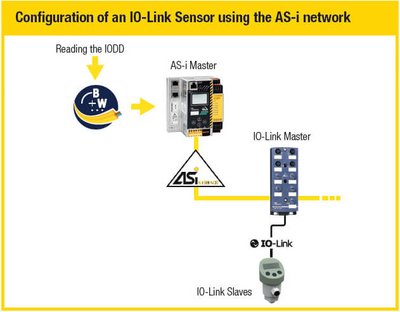Does it fit or doesn't it? – AS-Interface and IO-Link
As is so often the case with that wretched stereotyped thinking: sometimes it leads you miles away from reality. A perfect example of this is the often-heard view that AS-Interface and IO-Link are competitors. Nothing could be further from the truth. In reality, both systems play together perfectly and combine the advantages of their respective technological worlds. It has always been this way – and in the age of industry 4.0 this will become even more important.
It should be obvious that the smart factories of tomorrow will represent new challenges for sensors and actuators. This is one of the reasons why the intelligence offensive in this field began long ago. Management consulting company Roland Berger estimates that, compared with 2015, the sales of intelligent sensors will double to around 30 billion units by 2020. Many of these will surely serve their time in automated vehicles – but a continuously growing number of intelligent sensors will also be used in IoT applications and in modern production facilities.
There, intelligent sensors and actuators are already today making their advance. For good reason: because in addition to their previous core competency – namely recording variables such as temperatures – smart sensors can also be configured and are to some extent even able to prepare and pre-process the signals. That way, threshold values can, for example, be stored in an IO-Link device and, when these limits are exceeded, corresponding information can be transmitted. Even changes to the functions of the sensor are easy to make.
Fig. 1: Integration of IO-Link into AS-Interface using the IO-Link configuration tool from Bihl+Wiedemann
One significant element in this context: IO-Link is not a bus system, although, masters are also a common component to which multiple devices can be connected. But in fact it is a point-to-point connection which is used in an automation environment typically below the I/O level for connecting field devices individually. This alone should make it clear how irrational the often repeated opinion is that AS-Interface and IO-Link are to be seen as competitors. For the wiring system ASi, IO-Link can rather function as an ideal feeder, in which case the two systems play together perfectly as a true dream team. This also has to do with the fact that even in the most modern machines, far from all artificial sensory organs need to be intelligent. Thus, for the majority of sensors digital I/O data is quite sufficient: a smart proximity switch for example would most likely be over-qualified in many positions. A big benefit of linking-up using AS-Interface is the fact that all data can be collected – regardless of whether it originates from intelligent sensors or from their less clever counterparts. This means the user does not need to waste time thinking about whether he may want to someday upgrade to an intelligent sensor in one location or another. And in the entire line he profits from the almost literally benefits of AS-Interface: from the typical simple ASi installation using just one cable for data and power to the freely selectable topology and the low wiring effort up to the optimal granularity of the communication system which makes all the inputs and outputs available exactly where they are needed. Since the Gateways from Bihl+Wiedemann collect all the sensor data in advance and even permit pre-processing if needed, the higher level fieldbus is also unburdened.
Fig. 2: In addition to standard sensors / actuators and safety components, IO-Link devices can also be easily integrated into an ASi network
Simplicity also characterizes the configuration of the IO-Link Sensors using AS-Interface – or more precisely, using the fieldbus and the diagnostic interface in the Gateways from Bihl+Wiedemann. Here, all you need is a software program for all the sensors, regardless of how intelligent they are or who made them. The IO-Link Slaves are configured using the IO Device Description (IODD) in plain text. All the user has to do is start the Bihl+Wiedemann software and then select the IO-Link Master, the port with the desired sensor and its IODD. Conceptually it works like this: the IO-Link Master, which collects the IO-Link Sensor data on the level below AS-Interface, is at the same time an ASi Slave and as such is integrated into the AS-Interface network as usual. In other words: on this level the same thing happens as what one level above has always been considered the key to maximum efficiency when linking-up actuators and sensors. There, the ASi Masters fit in as Slaves in the higher-level fieldbus. The result is an especially powerful team in which each player is doing what he does best.




